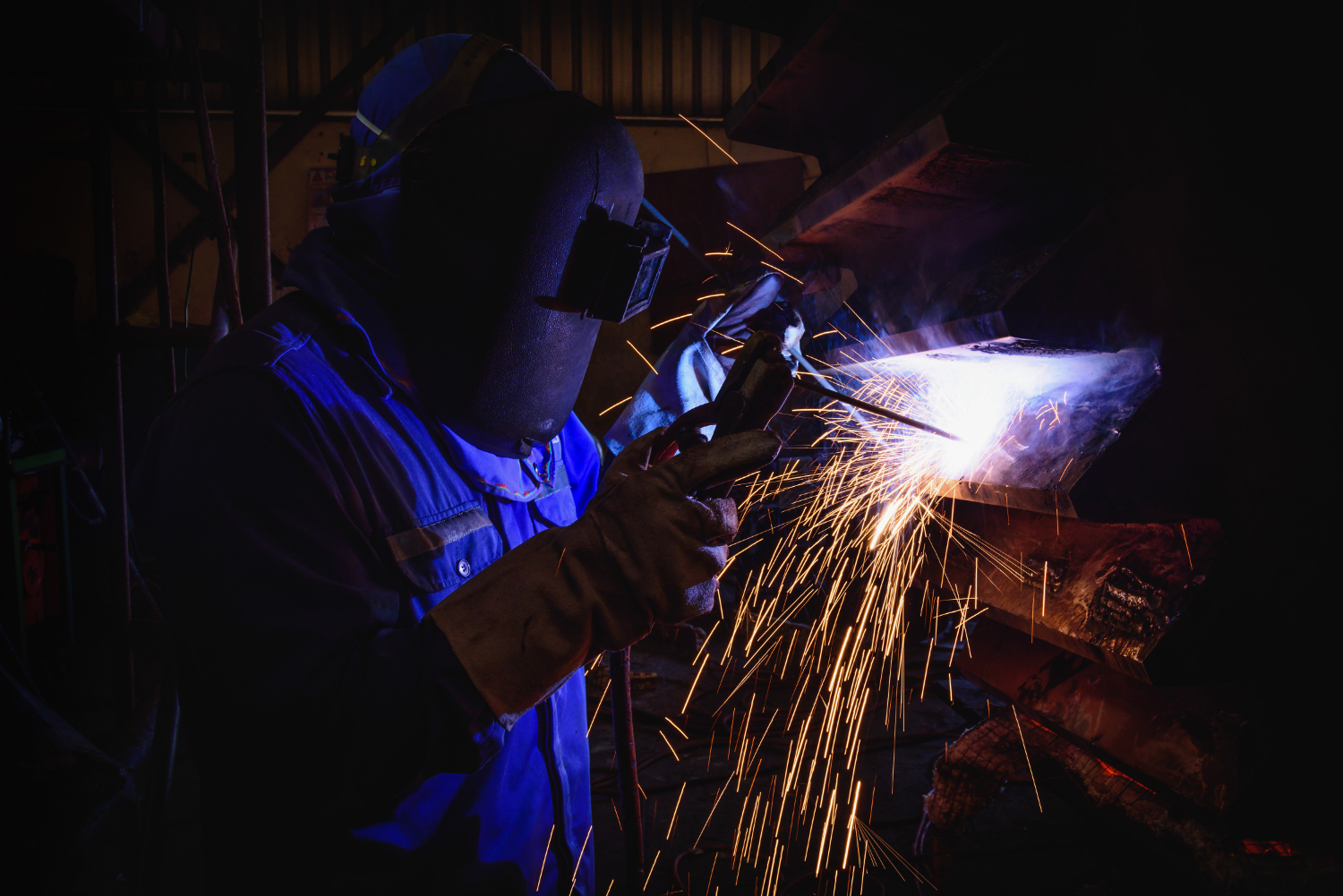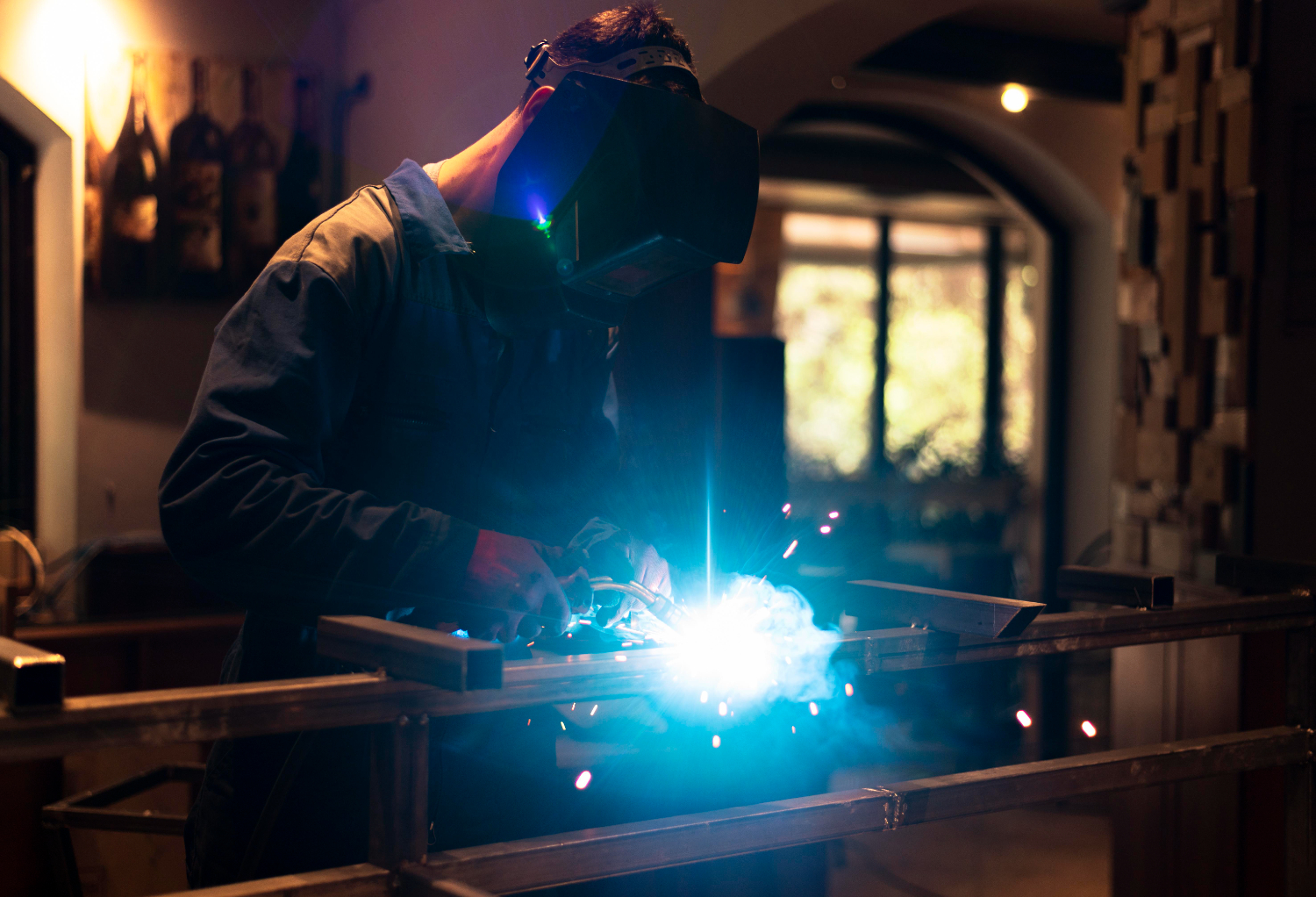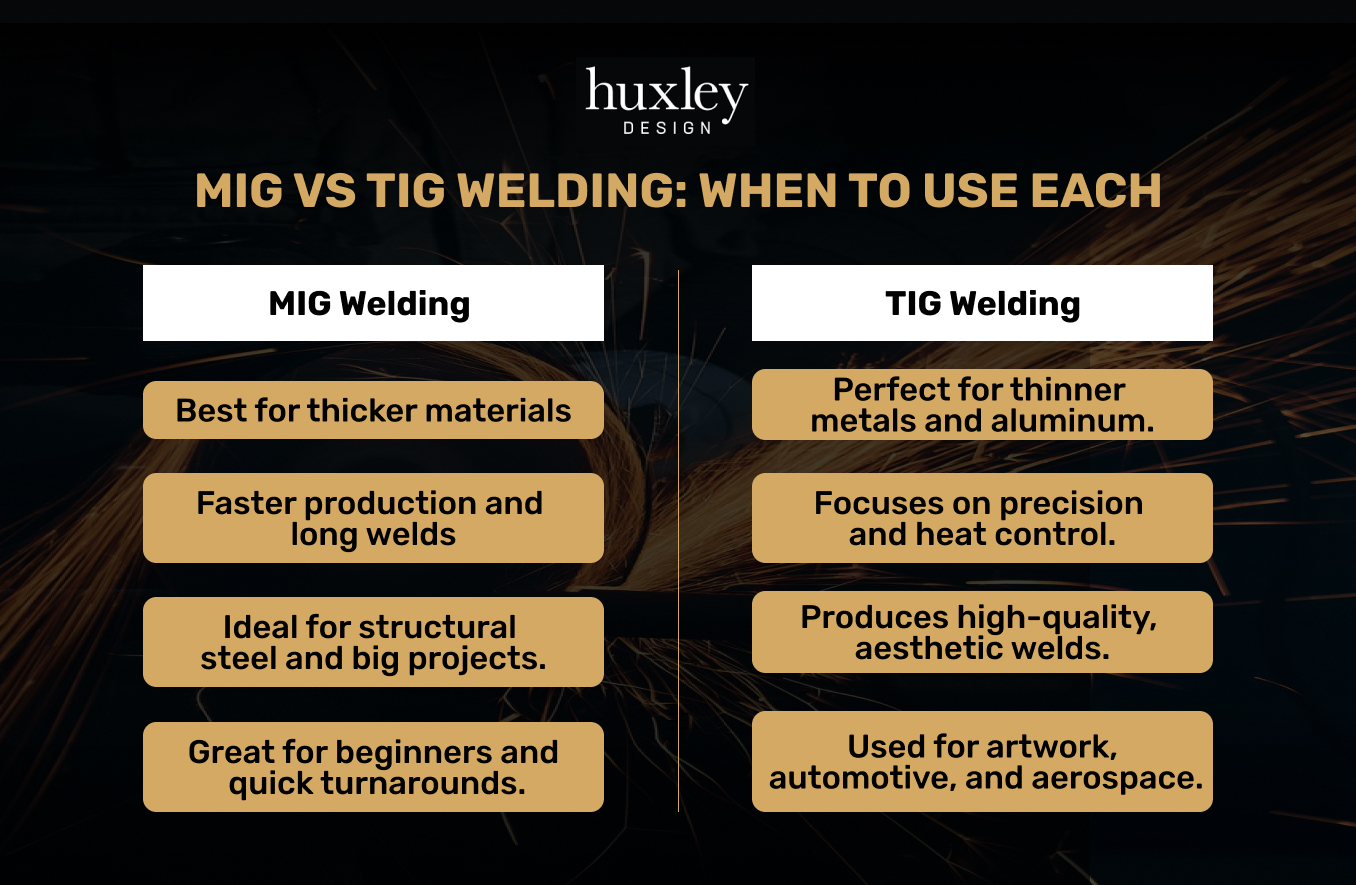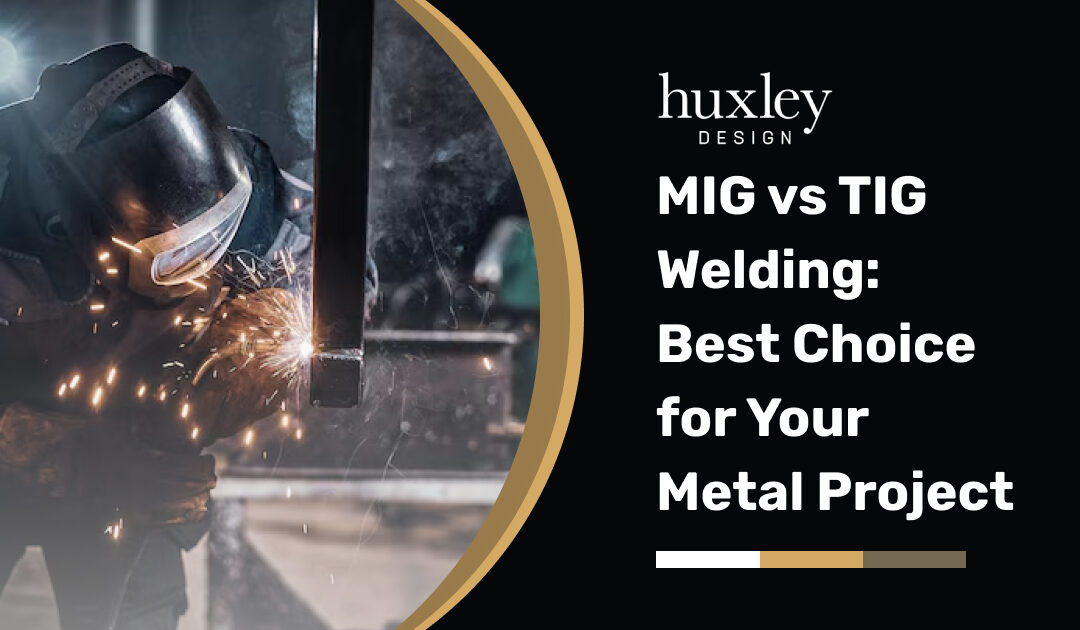Welding is like the glue that holds metal pieces together, but choosing the right type is key to a successful project. When it comes to MIG vs TIG welding, each has its own strengths, and picking the best one depends on your project’s needs. Understanding how they work can save you time, money, and effort.
MIG vs TIG welding often sparks debate, especially for beginners or anyone tackling a metal project. MIG welding is fast and great for thicker metals, while TIG welding shines in precision work. Let’s dive in to figure out which is the perfect fit for your next project!
Table Of Contents:
- MIG Welding: Your Workhorse for Thicker Materials
- TIG Welding: The Artist’s Touch for Precision
- MIG vs TIG Welding: Which Method to Use and When?
- How Huxley Design Supports Your Metal Projects with MIG Welding
- FAQs about MIG vs TIG Welding
- Conclusion
MIG Welding: Your Workhorse for Thicker Materials
MIG welding, or Metal Inert Gas welding, is like the dependable workhorse of the welding world. It uses a continuously fed consumable wire electrode, acting as both the electrode and the filler metal, making it super-fast. This high deposition rate makes MIG a top pick for larger projects and thicker materials. Because you only need one hand to operate the MIG gun, you’ll get up to speed pretty quickly, even as a beginner. 
Advantages of MIG Welding
- Speed: The constantly-fed wire means you can lay down welds in a hurry, which is a game-changer when deadlines and budgets are tight.
- Simple to Learn: With a MIG setup, you can start making decent welds pretty quickly, making it ideal for beginners.
- Great for Thicker Materials: MIG welding shines with thicker materials, allowing for deep penetration.
- Versatile: MIG welding can handle different metals and welding positions.
Disadvantages of MIG Welding
- Less Precise: While you can create nice MIG welds with skill, the results aren’t generally as picture-perfect as TIG welds. This can limit MIG welding on applications needing clean aesthetics.
- Not Great for Thin Materials: MIG’s high heat input might not be ideal for delicate projects and thin sheet metal prone to warping.
TIG Welding: The Artist’s Touch for Precision
TIG welding, short for Tungsten Inert Gas welding, offers incredible precision. This makes it the go-to for detail-oriented projects and produces high-quality welds. It uses a non-consumable tungsten electrode to create the arc, and you manually feed a filler rod. This two-handed approach may take some getting used to, but it offers finer control over the weld pool. The concentrated arc means TIG excels at thin sheet metal, usually with less distortion or discoloration. Projects look visually cleaner because there’s usually less spatter and fewer defects. Some describe MIG vs TIG as welding with a broad stroke of color vs a paintbrush, but both have merit. 
Advantages of TIG Welding
- Precision and Control: You have excellent control over the heat and filler material, allowing you to fine-tune the result. The slower process compared to MIG provides more control.
- Perfect for Thin Materials: TIG’s low heat input works well on thinner materials where MIG’s high heat might cause warping.
- Aesthetically Pleasing: TIG welds have smooth, aesthetically pleasing beads. Some projects, like art and design, demand this aesthetic.
- Versatile Across Materials: TIG performs well on a broad spectrum of metals, including stainless steel and even some harder-to-weld materials.
Disadvantages of TIG Welding
- Steeper Learning Curve: TIG welding requires more practice and patience than MIG welding. Experienced welders often prefer TIG for its control.
- Slower Process: TIG welding is a detailed and slower process, impacting project timelines. The use of a foot pedal enhances control but contributes to the slower pace.
- Costlier: Both the TIG welding equipment and the expertise needed often make projects more expensive.
MIG vs TIG Welding: Which Method to Use and When?
So, how do you pick between these two top-notch arc welding techniques? Selecting between MIG vs TIG welding depends mostly on skill level, project needs, and the materials used. The wire feed speed in MIG welding contributes to its higher production rates. 
MIG excels with thicker materials, long welds, quick turnaround times, and when you have limited welding experience. Think structural steel, big projects where strength and speed matter more than artistic looks. This makes MIG a popular choice for many common welding applications. TIG shines on thinner sheet metal, stainless steel, and aluminum where precision, appearance, and managing heat are key. This slower process produces exceptional results where quality is paramount. Picture intricate artwork, automotive parts, or aerospace work where appearance is crucial. TIG welding is also beneficial when welding aluminum and other tricky or sensitive materials. It is even used for underwater pipe repair. This handy chart sums up MIG vs TIG welding, highlighting their roles within various industries:
| Feature | MIG | TIG |
|---|---|---|
| Speed | Faster | Slower |
| Skill Level | Easier | Harder |
| Material Thickness | Thicker | Thinner |
| Precision | Lower | Higher |
| Aesthetics | Good | Excellent |
| Cost | Lower | Higher |
This MIG vs TIG comparison should give you a starting point when deciding on the right solution for your welding project.
How Huxley Design Supports Your Metal Projects with MIG Welding
At Huxley Design, we focus on delivering top-notch welding and fabrication services tailored to your specific needs. MIG welding is one of our specialties, and we ensure every project we take on is executed with precision and care. Here’s how we make a difference when it comes to your metal projects:
Why We Focus on MIG Welding
MIG welding is versatile, fast, and perfect for a wide range of metal projects. At Huxley Design, we use MIG welding because it is an efficient method for creating strong, reliable joints, even on larger-scale or complex designs. This allows us to deliver durable results for industries and projects that demand high quality.
What We Offer in MIG Welding Services
We use cutting-edge techniques and tools to meet your metal fabrication needs. Here’s what sets our MIG welding services apart:
- Expert Craftsmanship: Our team has years of experience working with MIG welding to ensure precise and professional results. From industrial applications to custom designs, we handle each project with attention to detail.
- Tailored Solutions: Every project is unique. That’s why we work closely with you to understand your vision and design needs, using MIG welding to create solutions that match your goals.
- Strength and Durability: The projects we complete with MIG welding are built to last. Our focus is on creating solid metal joints that stand up to wear and tear, ensuring long-term performance.
- Fast Turnaround Times: MIG welding is ideal for completing larger projects quickly. Our team uses this advantage to deliver results on time without compromising quality.
Our Commitment to Quality
At Huxley Design, we are committed to ensuring that every weld meets our high standards. By using MIG welding for its reliability and efficiency, we deliver projects that not only meet your specifications but exceed your expectations. Whether it’s a small project or a large-scale fabrication, we ensure the end result is something you can trust and be proud of.
How We Can Help You Choose the Right Welding Method
While MIG welding is our specialty, we’re here to guide you if you’re unsure which welding process best suits your project. Our team can discuss your requirements, such as the type of metal, project size, and desired appearance, to ensure we provide the best solution.
Industries We Serve
Huxley Design’s MIG welding services cater to a variety of industries, including:
- Industrial Manufacturing: From machine parts to heavy-duty equipment, our welding ensures functionality and durability.
- Custom Fabrication Projects: If you have a unique idea or need a custom solution, we bring your vision to life with precision MIG welding.
- Architectural and Decorative Metalwork: Our MIG welding expertise extends to creating aesthetically pleasing and structurally sound metal designs.
Why Trust Huxley Design for Your Metal Projects?
Here are a few reasons clients choose us for their MIG welding needs:
- Experience You Can Rely On:Our skilled team has a track record of delivering exceptional results for projects of all sizes.
- Clear Communication:We prioritize understanding your needs and keeping you informed every step of the way.
- Customer-Centric Approach:Your satisfaction is our top priority. We tailor our services to fit your goals and ensure the final product meets your expectations.
FAQs about MIG vs TIG Welding
Which is better MIG or TIG welding?
Neither MIG nor TIG welding is inherently “better.” The ideal choice depends entirely on the project. MIG is preferable for speed, value, and ease of use, particularly with larger projects and thicker materials. TIG is the better option if appearance and precision are paramount, especially when working with delicate or tricky materials like aluminum. Choosing between the two depends on your specific needs and desired outcome. TIG welding, while slower, produces exceptional quality and is preferred for high-end applications.
Is it better to start with MIG or TIG welding?
Starting with MIG welding is often easier for beginners due to the smaller learning curve. The MIG welding process, with its wire feed and simpler setup, allows novice welders to gain experience more quickly. It uses a consumable wire electrode, while TIG welding utilizes a non-consumable tungsten electrode. Once you’re comfortable with MIG welding, adding TIG welding to your skillset can be beneficial. Learning both broadens your welding capabilities, allowing you flexibility in various applications. These two gas welding techniques offer distinct advantages depending on the project requirements. Each uses shielding gases and filler metals in the form of welding wire (MIG) and filler rods (TIG). Understanding the differences in heat transfer, wire feed speed, and welding parameters will further improve your skillset.
Do MIG welders need gas?
Most MIG welding uses shielding gases like argon, or a mix of argon and CO2, flowing from the MIG gun along the wire. The proper shielding gas protects the weld pool from atmospheric contamination. For cost-sensitive projects, flux-cored MIG welding is an option, although it creates more spatter and requires post-weld cleanup due to slag formation.
Can you MIG weld aluminum?
Yes, you can MIG weld aluminum, but it’s more complex than standard MIG welding. It requires 100% argon shielding gas and adjustments to various parameters like wire-feed speed (due to aluminum wire being softer). The “push” technique is employed to control the weld pool’s flow, ensuring optimal results. Specific settings depend on material thickness, further emphasizing the intricacy of aluminum MIG welding. This makes aluminum TIG welding the often preferred method, particularly with thinner materials where precision and minimizing the heat affected zone is critical. TIG welding offers more control, especially over the heat input, minimizing the risks of material warping or distortion. While experienced welders may find it manageable, it does add complexity compared to welding stainless steel or thicker materials.
Conclusion
Choosing between MIG vs TIG welding ultimately comes down to the needs of your project. Whether you prioritize speed, strength, or precision, understanding the strengths and limitations of each method will help you make an informed decision. MIG welding is ideal for larger, faster projects, while TIG welding excels in detailed, high-quality finishes.
At Huxley Design, we specialize in MIG welding, offering exceptional craftsmanship, tailored solutions, and durable results for a wide range of metal projects. With years of experience and a commitment to quality, we ensure your project is completed to perfection. Contact us today to discuss your welding needs and discover why Huxley Design is the best choice for your next metal project!



Recent Comments